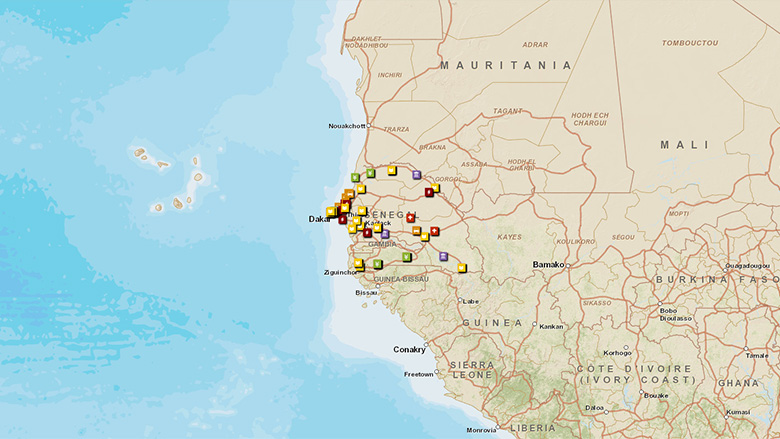Challenge
The benefits from economic growth over 1995-2005 were much lower in rural areas relative to urban areas, increasing the rural-urban gap in terms of incomes and socio-economic infrastructure and services. Although the 2001 Poverty Reduction Strategy Paper (PRSP) aimed to improve access to basic services and outcomes through increased decentralization and basic service delivery, public funds were largely spent at the central level and did not reach rural areas where services were most needed. This was the main challenge that this project was trying to face.
Solution
The International Development Association (IDA)-funded Participatory Local Development Project (PLDP) was designed in line with the 2003 Senegal Country Assistance Strategy (CAS), which derived directly from the Poverty Reduction Strategy Paper (PRSP). The PLDP was complementary with other World Bank-supported projects and fit well into the World Bank Africa Action Plan.
Results
Under the prime minister’s leadership during the fall of 2005, the Government of Senegal adopted a full community-driven development (CDD) approach, which translated into the Participatory Local Development Project (PLDP) in the amount of US$100 million (IDA: US$50 million and the government: US$50 million).The project was designed as a transition toward further budget support projects, by making the largest possible use of regular financing channels of the government. The purpose of the project was to share growth by scaling up social and human development through the improvement of access of the poor to a minimum package of essential services, including health, education, and water. The project development objective (PDO) was to assist the Government of Senegal in setting up an effective framework for participatory local development, decentralization, resource mobilization and transfer to local governments and communities, to deliver services in rural areas and targeted poorest cities efficiently. The project was implemented in five years (2007-2011).
To deliver services at the decentralized level, the project succeeded in building and equipping 1,188 classrooms, 176 sanitary facilities for schools; constructing 2,358 water systems (407 wells, 52 boreholes, standpipes, private connections, water tanks, water towers); 311 health centers; 46 maternal wards and 1,218 commercial infrastructure investments in all 14 regions of the country. The cumulative resources transferred from the national government to local governments during the project lifetime reached US$48.8 million, with a target of US$42.6 million. Also, the number of training sessions exceeded planned targets and the project succeeded in conducting important reforms and building institutions at the local level.
The PDLP benefitted more than 2 million people of which 900,000 were women, out of a target of about 1.3 million people living in 110 small towns (communes) and 320 rural communities. The implementation of the project lasted five years (2007-2012).
In education, the project contributed to lower dropout and repetition rates in all schools where it intervened. In schools benefitting from the project (2008-2011), only 2.1 percent of students dropped out, compared with a national rate of 9.3 percent. The percentage of students who had to repeat the same grade was 0.2 percent under the project compared with a national rate of 3.1 percent.
In health, during the same period, the quantity of health care activities provided by the project-built health facilities increased from 6,900 to 8,600 interventions, which is 60 percent higher than comparable health facilities outside the project area.
Investments in potable water supply through standpipes and wells reduced the average distance to fetch water from 17.7 to 7.4 kilometers for standpipes and from 12 to 3 kilometers for wells. Daily household water consumption increased by 13 liters and water quality improved.
Taxes collected from newly built markets increased local government (LG) revenues and local employment was also generated. Through the decentralized decision-making process for local micro-projects, there are indications that the unit investment costs were lower for the sub-sectors covered by the project, compared to similar micro-projects realized by different partners of government institutions in education, water and health.
On the institutional side, the project effectively assisted the government in promoting relevant policies and setting up a coordinating and executing mechanism for decentralized local participatory development. This contributed to building LG capacity and improving local governance, stimulating the local economy and scaling up human development through the improvement of access by the poor to a minimum package of essential services.. The LGs appreciated the fact that they have the opportunity to develop their own local development plans, and prioritize their investment needs. In the process of executing hundreds of local micro-projects, local stakeholders report an increase in social capital because local actors learned to collaborate to ensure projects were completed and sustained, including in managing contracts and budgets, and setting up maintenance arrangements.
Bank Group Contribution
The IDA contribution to the project totaled US$53.85 million disbursed. The government was satisfied with the results of the project and formally requested financing for a second phase. IDA is likely to support further decentralization through budgetary support linked to policy reforms.
Partners
As part of the project, the Government of Senegal has succeeded in leveraging a partnership with the following organizations:
- UNDP: United Nations Development Programme
- UNCDF/FENU: United Nations Capital Development Fund/Le Fonds d'équipement des Nations unies
- LuxDev: Luxembourg Development Agency
- Canada: Canadian cooperation, including CIDA
- German cooperation.
Moving Forward
Providing socioeconomic infrastructure has been the main activity of the project, which is appreciated by all stakeholders. For the majority of them, these achievements are in line with their needs. However, the participatory local development and decentralization approach, and resource transfer to the LGs and communities to deliver services in rural areas, is unlikely to be reversed, although the pace of future reforms is uncertain.
Beneficiaries
As one beneficiary, the President of the Rural Communities Association, put it “Donors come and go. "What made the difference with this project are the actions which have been included in the national budget and time".
